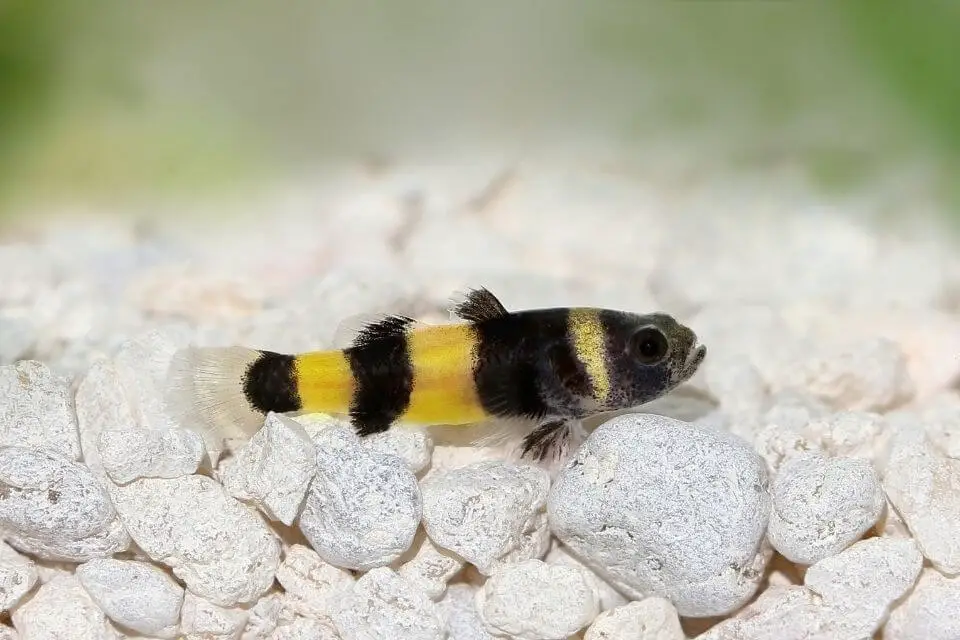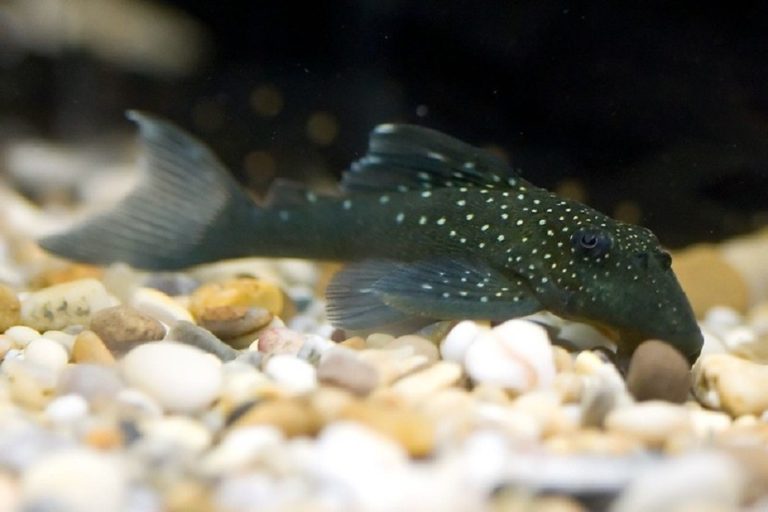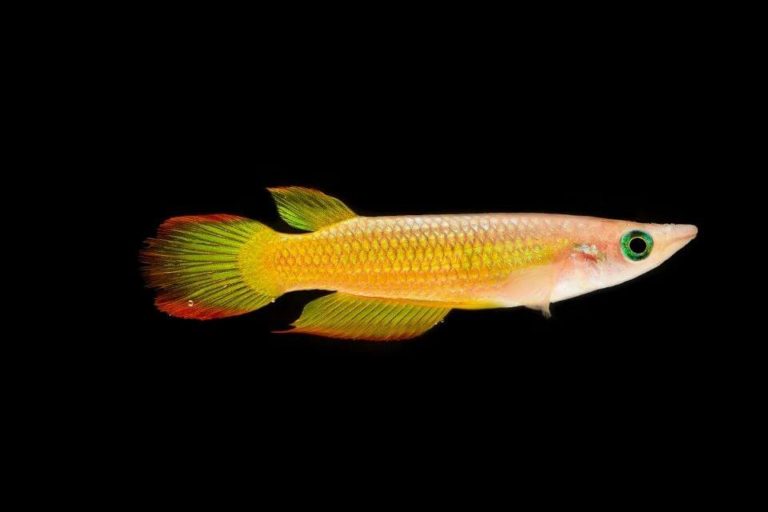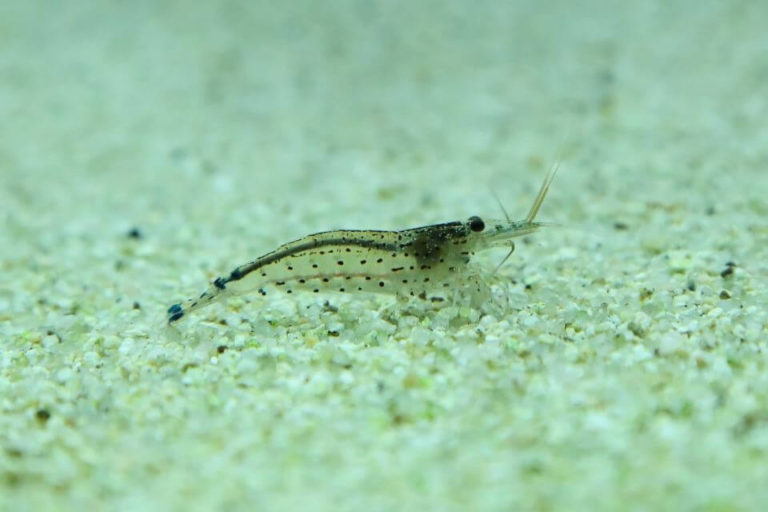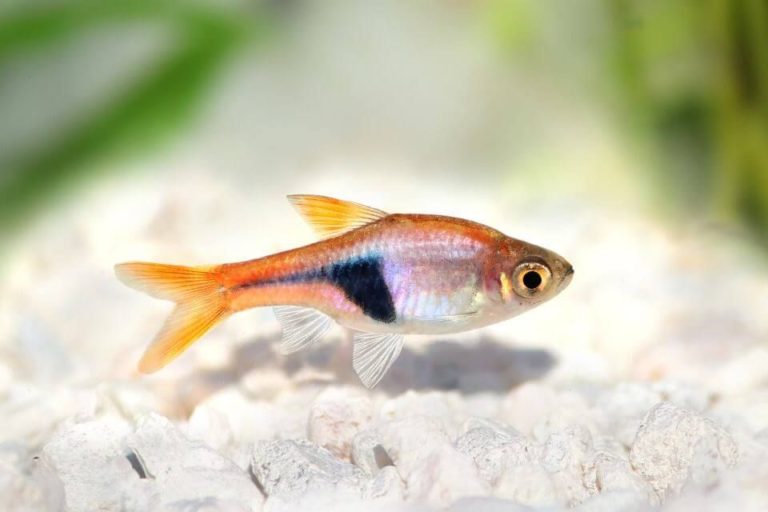Dwarf Gourami Care 101 – Tank Mates, Tank Setup, Diet, Breeding & More
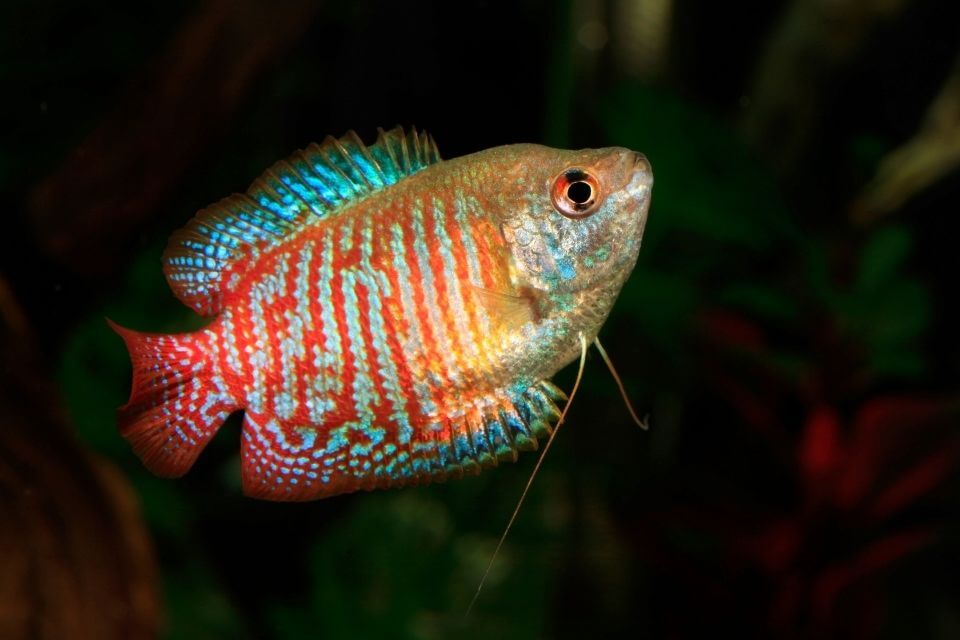
Dwarf Gourami is a genuinely striking freshwater fish species with an appearance that is sure to catch the attention of anyone who sees them. They are famous for this reason, but they come at a cost.
These Gourami species require particular care to survive long enough to be enjoyed by their keepers. The most important part of Dwarf Gourami care is their requirement for warm water and high oxygen levels.
Both of these factors must be considered when it comes to housing and diet. If you’re willing, let’s go over everything you need to know about Dwarf Gourami Care!.
| Quick Facts: | |
|---|---|
| Common Names : | Dwarf Gourami |
| Origin : | Native to Southeast Asia countries |
| Family : | Osphronemidae |
| Scientific Name : | Trichogaster lalius |
| Care Level : | Medium |
| Temperament : | Generally peaceful |
| Social : | Community friendly |
| Diet : | Omnivores |
| Size (average) : | Up to 3 inches |
| Lifespan : | Up to 5 years |
| Breeding : | Egg layer |
| Minimum Tank Size: | 10 gallons |
| Tank Environment : | Freshwater, Gravel or sandy substrate, Lot of plants, Rocks, Caves, and Driftwood |
| Temperature : | 72 – 82 °F (22 – 28 C) |
| Water Hardness : | 3 – 12 dGH |
| Water pH Level : | 6.0 - 7.5 |
Species Overview
The Dwarf Gourami is scientifically called “Trichogaster lalius” that belongs “Osphronemidae” fish family.
It is previously referred to in the aquarium trade as ‘the poor man’s Neon,’ is a small labyrinth fish with specific care requirements. The most readily seen of these are its need for pristine water conditions and its intolerance of other Gourami species sharing the same tank.
They are highly sensitive to changes in water chemistry. You should not introduce it into new tanks, but purchase already maintained tanks. The high level of care required by this fish might at first dissuade hobbyists from keeping them.
They are beautiful fish. They have long flowing fins and vibrant orange scales. The Dwarf Gourami is peaceful, active, and hardy. They are the ideal community fish that won’t cost you the earth!
Dwarf Gouramis are easy to care for as most Gouramis. This fish is a surface-breathing fish that can often be seen darting to the surface to gulp air into their labyrinth organ. This allows them to live in oxygen-deprived water conditions but requires space to be left open at the top of the tank.
The tank should be well-planted with areas for retreat. They require clean, well-filtered water to thrive well. This makes them unsuitable for newly set up tanks or heavily crowded tanks with poor filtration systems.
Origin and Distribution
The Dwarf Gourami is native to the forest streams of India and Thailand, where it can be found swimming in the deeper waters. The Dwarf Gourami has been widely introduced into tropical Asia.
Its natural habitat covers much of northern India, Sri Lanka, Pakistan, Bangladesh, Myanmar (Burma), Thailand, Cambodia, Vietnam, and the Malaysian peninsula.
They are now found throughout South-East Asia. They often live among plants at the bottom of ponds, where their beautiful coloration helps them blend into their surroundings to avoid predators like birds that search for prey visually.
Dwarf Gourami Size
The Dwarf Gourami can grow up to three (3) inches in length in the wild. If kept in a captivity environment, the fish will usually only be about 2.5 inches long.
So an aquarium of at least 10 gallons is necessary if you want to keep more than one dwarf Gourami.
Males may grow slightly larger than females; however, these fish generally do not reach the same maximum size as other members of their genus.
Dwarf Gourami Lifespan
The Dwarf Gourami lifespan is about five (5) years if they are well taken care of. They can live up to 10 to 12 years with excellent conditions and plenty of food.
A Dwarf Gourami’s tank should have an area for hiding because the fish are pretty shy when kept alone. It also helps if there are numerous plants in their tanks so that they can feel secure leading to reducing the stress level.
Living in a stressful environment enhances the lifespan of your fish.
Types of Dwarf Gourami and Appearance
– Honey Dwarf Gourami
The Honey Dwarf Gourami is a very beautiful fish. It has a brilliant yellow body with dark blue lines running vertically down the length of the fish’s body. The belly of this fish is orange in color.
This species comes from Thailand and Malaysia, where it lives in slow-moving rivers, ponds, swamps, and flooded rice fields.

– Powder Blue Dwarf Gourami
The Powder Blue Dwarf Gourami has brilliant blue scales edged in black, giving them a scalloped appearance. Their fins are large white fringed with blue.
The dorsal fin on this particular species stands straight up rather than folding into itself like most other Gouramis.
– Flame Dwarf Gourami
Flame Dwarf Gourami’s body coloration varies depending on the light source but generally has a brownish pink base with red stripes that run vertically down the length of its body.
Their fins are clear or white, with some red patches along their rear edge. The dorsal fin folds into itself instead of standing straight up.
– Blue Dwarf Gourami
Their body coloration varies between light blue and purple, depending on the lighting in the aquarium. The fins are transparent, with some red coloring around their edges.
Blue Dwarf Gourami fish have a straight dorsal fin instead of folding it into themselves.
– Neon Blue Dwarf Gourami
Neon Blue Dwarf Gourami has a royal blue base color with a bright green belly and stained-glass appearance due to iridescent blue scales along its sides, especially near its dorsal fin.
The dorsal fin stands straight up rather than folding into itself. Its fins have to edge those contrasts against the rest of its body.
– Red Dwarf Gourami
The Red Dwarf Gourami is probably the most famous Dwarf Gourami breed because it is also one of the largest, growing to around 3 inches long in captivity.
It has a deep red body color with iridescent blue spots along its body. Its fins are clear or white, edged in red.
Behavior & Temperament
The Dwarf Gourami is generally peaceful but may become territorial with other fish based on the environment that they live in. You can house them with other temperate species of the same size or larger.
However, they should not be kept in a community tank with aggressive fish because they will likely be chased and stressed by more boisterous tankmates.
Fish may behave differently when there are no visible means of escape, e.g., hiding places. Hiding places provide them comfort and security. Therefore, it’s essential to offer plenty of driftwood, plants, smooth rocks, and an open area for swimming in your aquarium.
They do best in groups of three (3) or more individuals per species. Checking local availability and purchasing these fish when they are young is best.
Dwarf Gourami Care
Dwarf Gourami is not demanding fish. They will thrive in a wide range of water conditions. You can keep in the same aquarium with other community fish, but they might nip at long-finned fish, so it’s better to avoid them when keeping Dwarf Gouramis.
Some aquarists suggest that you should keep only males to avoid fights. However, too many males in one tank could cause conflicts and stress due to the lack of hiding places. Many hobbyists recommend keeping three (3) females with one male to reduce aggression and breeding problems.
You may add some salt in their tank, i.e., half a teaspoon of aquarium salt per gallon of water. This is to increase their vitality and disease resistance. This will also make the fish look better and relieve itching.
Do not keep Dwarf Gouramis in high temperatures. They like it around (22 – 28 degrees Celsius). They can survive in low temperatures but not for a long time; if you notice your fish spends much time near the filter outlet avoiding colder areas, then try to get a heater.
– Dwarf Gourami Tank Size
The recommended tank size for Dwarf Gouramis is at least 10 gallons, and the bigger, the better. Most tanks come with hoods with lights on them or light-bulbs already installed within them.
You shouldn’t consider anything under an aquarium of 10 gallons because it’s not big enough to provide your fish with appropriate living space. A tank that holds 10 gallons of water is enough to support the kind of natural environment this fish would be accustomed to in its native habitat.
If you plan to have more than one fish just add 5 gallons more for a single fish as a general swimming space for them to thrive well and be happy.
– Dwarf Gourami Tank Setup
If you’re going to use a substrate, use a 1-inch thick layer of gravel. Avoid the fine ones, your Dwarf Gourami may accidentally ingest some while foraging for food. You can add some smooth rocks and driftwood pieces but make sure they are not too large.
It will be difficult for your fish to move around the tank comfortably. If you add any decorations such as rocks and driftwood, rinse them thoroughly before adding them into the tank.
– Water Conditions and Parameters
The recommended pH for their aquatic environment is a slightly acidic level of 6.0 to 7.5, with a general hardness anywhere from 3 to 12 degrees and a temperature range of 72 – 82 °F (22 – 28 degrees Celcius).
Anything outside these parameters may not only affect the overall health of your fish. It will also contribute to more significant than average stress levels at variance.

– Suitable Plants
These fish are incredibly adaptable. They’re not as picky about the plants they will or won’t take to, provided there aren’t any other Gouramis in their tank.
As long as you provide them with a well-cared for and maintained plant setup, they’ll leave it alone entirely. When you introduce other Gourami species into their environment, these otherwise peaceful species start to show aggressive behavior toward your live plants.
This is because those other fish view your live plants as potential food or playthings at best and hiding spots at worst. The good news is that these fish hardly ever destroy the roots of living plants.
But they will destroy soft-leaved plants like Hemianthus callitrichoides (dwarf baby tears) and Riccia fluitans (Crystalwort). This particular species of fish isn’t known to damage or uproot live plants, but this could vary depending on the temperament and behavior of individual fish.
However, if you decide to include live plants in your aquarium environment, it would be best to use fast-growing varieties because Dwarf Gouramis like to constantly pick at them for food until they’ve stripped all vegetation from the roots.
Few recommended aquarium plans are:
– Possible Dwarf Gourami Diseases and Prevention
Dwarf Gouramis are known to contract Fin Rot, Mouth fungus, and Bacterial infections. Just like in other species of fish, there are a few things you can do to prevent your Dwarf Gourami from contracting any diseases or infections, including the following:
Proper Quarantine:
Dwarf Gouramis should constantly be introduced into an established aquarium environment only after a proper quarantine outside the home tank.
During this time, their immune systems get accustomed to their new living conditions, while any possible illnesses or contaminations get flushed out through regular water changes.
Cleaning:
Regularly Clean the Filter And Replace the Carbon Cartridge- Dirty filters coupled with old cartridge filters make contaminations take root within the water. You should routinely clean your filter and remove the old cartridge before replacing them with new ones.
Check the Water Temperature:
Lowering the temperature of your aquarium can also help keep Dwarf Gourami diseases at bay because lower temperatures promote more excellent overall health in all forms of life, including fish.
Lower water temperatures make Dwarf Gouramis less susceptible to stress, which makes them more resistant to bacterial infections caused by increased respiration rates and lowered immune response.
To ensure that your fish will be safe from any form of disease or infection, you should regularly inspect each fish to make sure its scales look healthy and aren’t already covered with any white sores or patches.
Dwarf Gourami Food and Feeding
The first thing to be aware of when feeding Gourami is that they are picky eaters, so you need to make sure you are prepared for this before purchasing one. Gourami’s come from brackish waters, meaning there are quite a few differences in what they can live off compared with freshwater fish.
Dwarf Gourami food and feeding comes down to two different categories; natural foods and commercial foods.
Natural foods consist of anything they would eat in nature, such as algae, shrimp, insect larvae, etc., while commercial food has manufactured pellets for them to eat.
You must watch out because specific brands have too much protein in their foods, which leads to more harm than good.
Gourami will eat just about anything you feed them, although they prefer live foods if they can get them. Brine shrimp, tubifex worms, insect larvae, mosquito larva, and daphnia are all eagerly consumed by these omnivorous fish.
How Can You Tell If a Dwarf Gourami Is Male or Female?
Big bulging eyes and long anal and dorsal fins characterize Male Dwarf Gourami fish. Females have smaller bodies and shorter fins than the males of the species. Males will typically be more colorful when they’re in spawning mode.
If you decide to keep male Dwarf Gourami with other fish, ensure that there aren’t any similar-looking females. The male will aggressively defend his territory against anything that he feels is a threat to his relationship with the female of his choice.
On rare occasions, a male and female gourami may not show distinct physical characteristics that are easy to detect. If this happens, you can watch for spawning behavior instead.
Dwarf Gourami Breeding
Dwarf Gouramis are bubble nest builders. To induce spawning, ensure they are healthy and conditioned with live foods. Conditioning pairs by feeding them with live or frozen foods high in protein is ideal.
Examples include bloodworms, brine shrimp, or daphnia. Live plants can also bring out their natural breeding instincts.
When ready to spawn, females will appear plump, and males will chase her incessantly. Once she selects a site for her nest, she will continue to collect bubbles throughout the spawning act, which can take up to three days.
The male will fertilize the eggs right after they are laid; then, the female will scoop them up in her mouth and spit them into the nest. She will do this about three times until she has deposited all of her eggs into her nest in multiple batches.
The male will continue in his pursuit to mate with the female, and it’s even possible for a second male to sneak in and fertilize some of the eggs while she is distracted by another male! Although this does not happen often.
Dwarf Gourami Tank Mates
The Dwarf Gourami is a wide variety of Gourami because they come in many different color types, are graceful swimmers, and can be housed with other fish species with similar behaviors. They prefer tank mates that don’t grow too large, mainly smaller fish like Tetras or Guppies.
There are many reasons people want to keep these two types of fish together. Some believe the Gourami will act as a “watchdog” for other fish, while others like having an impressive-looking tank full of larger fish.
Some owners even report their Dwarf Gourami will act as a cleaner fish, eating algae off the sides of the tank.
Other possible tank mates to consider are:
- Galaxy Rasbora
- Tetras Species
- Loaches
- Catfish
- Swordtail Fish
- Mollies
How Many Dwarf Gouramis Should Be Kept Together?
As with other fish species, the number of Dwarf Gouramis to keep together depends on their size, tank size, and whether or not there is enough space for each of them to claim their territory.
An overly crowded tank can lead to stress, bullying amongst individuals, and increased aggression. They feel more comfortable when at least 3 Gourami fish are in together along with other species.
Keeping one male Gourami fish with 2 females would be the ideal combination to avoid aggression.
Why Is My Dwarf Gourami Chasing Other Fish?
Many Dwarf Gourami owners consider their fish to be docile and friendly. However, some report that they can become aggressive toward other fish in the tank. To understand what may cause this behavior, it is important to know about its natural habitat and behavior patterns.
Dwarf Gouramis are found in Asia, where swamps and flooded forests are common. They are used to an environment where open stretches of water are mixed with densely vegetated areas, making their territory constantly changing.
It is thought that this natural roaming behavior lends itself to the Dwarf Gourami’s territorial nature in captivity. While they may not be as aggressive toward tank mates as other fish, keeping more than one in a tank can cause problems.
The male’s courting ritual, which occasionally involves chasing other fish around the tank. It is believed that males use this courtship technique to drive away competitors and convince females of their masculinity.
The female may respond by favoring the more aggressive display. It may be possible that the female is confused by this behavior and will not participate in courting. This can lead to a decrease in spawning and eventually to her death.
Is Dwarf Gourami Aggressive?
Dwarf Gouramis are a relatively peaceful fish species. They can be kept in a community tank and not harass any other fish. However, they may be aggressive toward other Dwarf Gourami as well as some other diminutive species such as Neon Tetras and Guppies.
Because of this tendency toward aggression, keep only one male and several females in a tank. This fish is one of the smaller gourami species, and you can keep them with most community fish, including small Danios and Rasboras.
What Determines How Hardy a Dwarf Gourami Is?
Hardy generally means resistant to hardship, sickness, or injury. Dwarf Gouramis are hardy fish that can adapt to most conditions given. The overall hardiness of Dwarf Gourami is dependent on the environment it’s living in.
A happy and healthy fish will be more resistant to illness and injury than a sick or injured fish. Dwarf Gouramis kept in low-quality water with insufficient tank mates will be more vulnerable to disease and injury than a Dwarf Gourami living in perfect conditions.
Are Dwarf Gouramis Good Beginner Fish?
When choosing fish to start your first aquarium or looking to add more fish to your family’s tank, many beginner fish keepers talk about having Dwarf Gouramis. They are fish that aren’t super easy to care for but also not extremely difficult.
They can be a fun and rewarding pet, but you’ll need to ensure they are suitable for your particular situation.
Are Dwarf Gouramis Schooling Fish?
The term “schooling” usually implies that a group of fish is “swimming as one”. This doesn’t mean that all individuals have to be within a few inches of each other, but rather a solid, cohesive unit. Dwarf Gouramis, however, are usually not considered schooling fish.
In the wild, they have often observed swimming singly or in pairs not in a closely-knit group, as typical of schooling species. Dwarf Gouramis may even be decidedly unfriendly toward other members of their species unless they’re a mated pair.
Where to Find Dwarf Gourami for Sale?
As we mentioned above the Dwarf Gouramis consider a popular pet fish because of their bright yellow and black coloring. The aquarium trade often sells them because it is easy to care of. If you get one, make sure you understand the requirements of keeping it happy and healthy before you buy.
If looking for Dwarf Gourami for Sale, look at your local pet store or even online. These fish can live for several years, but they have specific water conditions and diet needs.
How Much a Dwarf Gourami Cost?
The cost of a Dwarf Gourami will vary from seller to seller and the size of Dwarf Gourami. When shopping for a Dwarf Gourami, make sure to ask the price before you buy one.
Look around and compare prices with what other sellers are asking. This way, you can get a good idea of its value and set a budget you don’t want to go over. They are available from price range from $7 to $15 range in the US market depending on the size and the color.
Final thoughts
The Dwarf Gourami is an active and peaceful addition to the community tank. You can keep them in groups of 3 or more individuals. They become stressed when alone or small and may develop behavioral problems such as excessive hiding and hostile behavior towards other tankmates.
These Gourami fish is hardy fish that adapts readily to new environments and lives in less-than-ideal water conditions. However, these same conditions make it an unsuitable choice for new hobbyists without extensive tank knowledge.
The above information should help you understand what this fish needs and how best to keep it.



